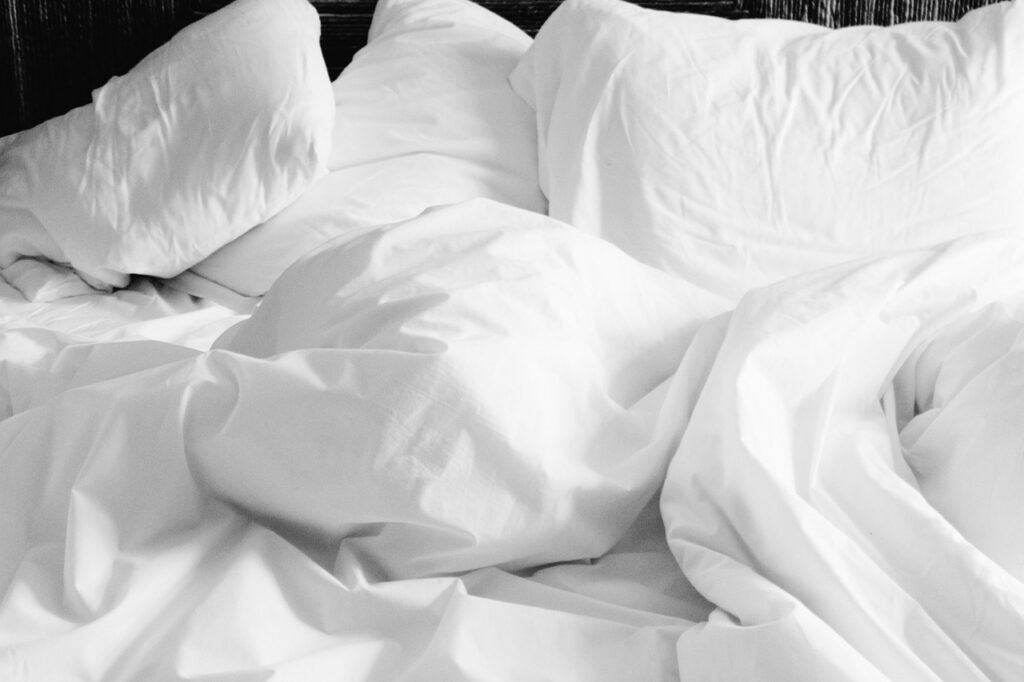As an Amazon Associate I earn from qualifying purchases.
A third of our lives is spent asleep, underscoring the importance of creating an optimal sleeping environment. The texture, warmth, and comfort of our sheets and pillowcases play a significant role in this. But with so many materials on the market, how do we choose the right one? This article compares cotton, linen, and silk —three of the most popular bedding materials—highlighting their unique properties, pros, and cons.
Cotton: The Enduring Favourite
Overview
Cotton stands as a testament to comfort and reliability in the realm of bedding materials. Esteemed for its softness, breathability, and resilience, cotton has adorned beds worldwide for centuries, offering a dependable and cozy foundation for a good night’s sleep. Its versatility and widespread availability make it a favorite choice for many, from budget-conscious students to luxury-seeking homeowners.
The Benefits of Cotton Bedding
-
Breathability: One of cotton’s most celebrated features is its breathability. The natural fibers allow air to circulate freely, helping to regulate body temperature and ensure a comfortable sleep environment. This makes cotton an excellent choice for both warm summer nights and cooler winter evenings.
-
Softness: High-quality cotton, like Egyptian or Pima, is renowned for its exceptional softness. This comfort only improves with time, as wash after wash, cotton bedding becomes even softer, enhancing the sleeping experience.
-
Durability: Cotton’s natural fibers boast impressive strength, contributing to the durability of cotton sheets and pillowcases. With proper care, cotton bedding can last for years, making it a wise investment for any home.
-
Easy Care: Another advantage of cotton is its ease of care. Most cotton bedding can be machine washed and dried, making it a practical option for everyday use. The material’s resilience means it can withstand frequent laundering without significant wear.
Choosing the Right Cotton
-
Varieties of Cotton: Not all cotton is created equal. Egyptian cotton, known for its long fibers, offers unparalleled softness and durability but comes with a higher price tag. Pima cotton, another high-quality option, provides similar benefits at a slightly more accessible price point. Upland cotton, the most common type, offers a more affordable but less luxurious alternative.
-
Thread Count and Weave: The quality of cotton bedding is often measured by thread count—the number of threads per square inch. While a higher thread count can indicate a softer and more luxurious sheet, it’s not the only factor to consider. The weave of the fabric also plays a significant role in its feel and durability.
Considerations When Choosing Cotton Bedding
-
Environmental Impact: Traditional cotton farming practices are known for their heavy use of water and pesticides, raising environmental concerns. Organic cotton options offer a more sustainable alternative, cultivated without harmful chemicals and often using less water.
-
Wrinkling: Cotton bedding is prone to wrinkling, which may require extra effort to maintain a crisp appearance, such as ironing or using wrinkle-release sprays. Some prefer the natural, lived-in look of slightly wrinkled cotton, while others may opt for cotton blends or wrinkle-resistant finishes to minimize this issue.
In Conclusion
Cotton’s appeal lies in its blend of comfort, practicality, and enduring quality. Whether you’re drawn to the sumptuous feel of high-thread-count Egyptian cotton or the straightforward comfort and affordability of Upland cotton, there’s a cotton bedding option to suit every preference and budget. By weighing factors like breathability, durability, and care requirements against personal values and environmental considerations, you can select cotton sheets and pillowcases that promise restful nights and peaceful dreams for years to come.
Linen: The Timeless Elegance
Overview
Linen, derived from the flax plant, carries a rich history and a reputation for elegance, strength, and natural beauty. Revered for centuries across various cultures, linen bedding offers a unique combination of durability, natural luster, and an unmatched cooling effect, making it a favored choice for those seeking both luxury and comfort in their sleeping environment.
The Benefits of Linen Bedding
-
Exceptional Comfort and Breathability: Linen is highly regarded for its excellent breathability, which is paramount for comfortable sleep, especially in warmer climates. Its natural fibers allow air to flow freely, effectively regulating body temperature and ensuring a cool, ventilated sleeping experience.
-
Durability: Among the strongest of natural fibers, linen becomes softer with each wash without losing its distinctive texture. This resilience ensures that linen sheets can last for decades, often outliving their cotton counterparts, making them a sustainable investment.
-
Moisture-Wicking Properties: Linen is inherently moisture-wicking, quickly absorbing and evaporating perspiration. This feature is particularly beneficial for sleepers who tend to overheat or sweat during the night, as it keeps the skin dry and comfortable.
-
Natural, Eco-Friendly Choice: The flax plant, from which linen is made, requires less water and pesticides compared to cotton, making linen a more environmentally friendly option. Additionally, every part of the flax plant is used, leaving no waste and further contributing to its eco-credentials.
Choosing the Right Linen
-
Understanding Quality: The quality of linen bedding is influenced by the origin of the flax, the manufacturing process, and the fabric’s weight. European flax, especially from Belgium and France, is often considered the finest quality due to the regions’ optimal growing conditions and longstanding weaving traditions.
-
Weight and Feel: Linen’s weight is measured in grams per square meter (GSM). Higher GSM linen is thicker and more durable, while lower GSM linen is lighter and cooler, making it ideal for summer months.
Considerations When Choosing Linen Bedding
-
Texture: Linen’s natural texture is more pronounced than that of cotton, giving it a distinct, rustic feel. While some may find this texture too rough initially, linen softens beautifully over time, enhancing its comfort with each wash.
-
Care and Maintenance: Linen requires a bit of special care to maintain its natural beauty. It can be machine washed, but should be air-dried and gently ironed if desired. Linen’s natural creases add to its charm, offering a casual, effortless look that eschews the need for constant ironing.
-
Investment: Quality linen bedding comes with a higher price tag compared to many other materials. However, its durability, health benefits, and the luxurious sleeping experience it offers make it a worthwhile investment.
In Conclusion
Linen bedding stands out for its natural elegance, unparalleled breathability, and sustainability. Its ability to improve with age, becoming softer and more comfortable over time, marks it as a timeless choice for those looking to invest in their sleep quality. While it may require a higher initial investment and a bit more care, linen offers a unique blend of luxury, comfort, and eco-friendliness that is hard to match, making it a distinguished addition to any bedroom.
Silk: The Luxurious Comfort
Overview
Silk, with its origins steeped in ancient luxury and elegance, remains a symbol of sophistication in the bedding industry. Produced by silkworms, this natural protein fiber is celebrated for its smoothness, sheen, and strength. Silk bedding is not just a testament to refined taste but also offers unique health and beauty benefits, making it a favorite among those looking to indulge in a touch of opulence every night.
The Benefits of Silk Bedding
-
Unparalleled Smoothness: Silk’s smooth fibers provide a frictionless surface, reducing the chance of hair tangling and skin creasing. This property makes silk an excellent choice for individuals concerned about hair health and skin aesthetics, as it helps maintain moisture levels and minimizes damage during sleep.
-
Natural Hypoallergenic Qualities: Silk is naturally resistant to dust mites, mold, and fungus, making it an ideal option for allergy sufferers. Its natural proteins can repel common allergens, ensuring a cleaner, more hygienic sleeping environment.
-
Thermal Regulation: Silk’s ability to conduct heat makes it an excellent material for bedding, as it can help maintain a comfortable body temperature throughout the night. It keeps you cool during summer nights and warm in the winter, providing year-round comfort.
-
Luxurious Aesthetics: Beyond its physical benefits, silk bedding adds an undeniable touch of luxury and sophistication to any bedroom decor. Its natural sheen and elegant drape can elevate the look of a room, reflecting a sense of style and refinement.
Choosing the Right Silk
-
Momme Weight: The quality of silk is often measured in momme (mm), with higher momme indicating a denser, more luxurious fabric. For bedding, a momme weight of 19 to 25 is considered ideal, offering a good balance between durability and comfort.
-
Type of Silk: Mulberry silk is the highest quality of silk available for bedding, known for its uniformity and durability. Other types, such as Tussah or Habotai, can also be used for bedding but may not offer the same level of smoothness or longevity.
Considerations When Choosing Silk Bedding
-
Care Requirements: Silk’s delicate nature requires gentle care to maintain its texture and sheen. It’s best to hand wash or use a gentle machine cycle and mild detergent, avoiding exposure to harsh chemicals and high heat.
-
Durability and Price: While silk is durable in terms of fiber strength, its delicate surface can be prone to snags and requires careful handling. Additionally, silk bedding is among the most expensive options on the market, making it a significant investment. However, for those who prioritize the unique benefits silk offers, it can be a worthwhile expenditure.
-
Imitations and Blends: Be cautious of synthetic imitations or silk blends that may compromise the natural benefits and feel of pure silk. Always check for certifications or purchase from reputable sources to ensure you’re getting genuine silk bedding.
In Conclusion
Silk bedding represents the pinnacle of luxury and comfort in the bedroom. Its health and beauty benefits, coupled with its elegant appearance, make it a coveted choice for those looking to invest in their sleep experience. While it requires careful maintenance and comes at a higher cost, the unique advantages of silk—ranging from its hypoallergenic properties to thermal regulation—justify its place as a premium bedding material. For those willing to indulge, silk bedding can transform every night into a sumptuous retreat, offering unparalleled comfort and sophistication.



